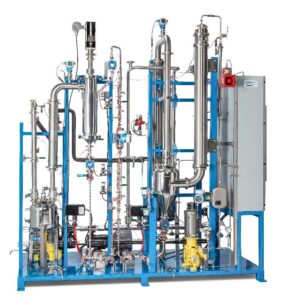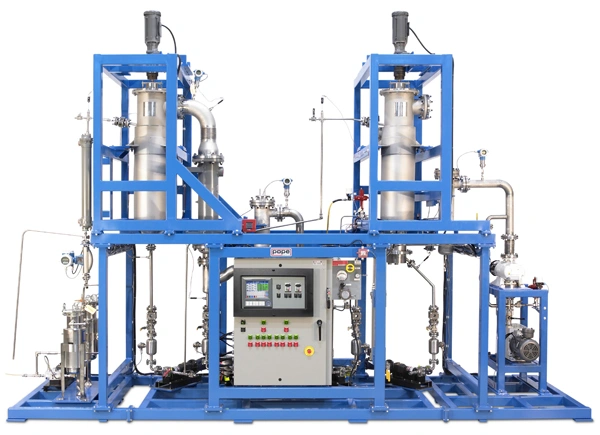Delivering Results
The Best Solution for Your Application in Lab – Pilot Plant – Production Sizes
This equipment is known by several names including Molecular Stills, Short Path Stills, Thin Film Stills, and Thin Film Evaporators. All are appropriate in describing the design, and functions of the equipment. There is a short distance between the evaporation and condensing surfaces, necessary for good transfer of vapor at high vacuum conditions. The feed liquid is spread and wiped for a short time as a turbulent thin film through the heated area, necessary for efficient evaporation of the more volatile components in the feed. These are key factors in this low successful, low degradation, high-yield distillation method.
Separate, evaporate, concentrate, or purify by using the superior process of short residence time, at a lower temperature, without degradation of your heat-sensitive material with the wiped-film technique. Examples of configurations for either distillation, evaporation, or concentration are shown.
Our engineers work with you to provide the right size for the best results for your application. Standard lab scale stills are available in 2″, 4″, and 6″ sizes with scale-up models for pilot plants and processing scales. The key to the most efficient thermal technique is utilizing Pope’s custom approach for your solution.
From lab scale to pilot plant to production scale, our custom configurations are ideally suited to your applications. A wide range of materials is offered for your custom configuration.
Still Versions
Wiped-Film Molecular Still – Also known as Short Path Still and Short Path Evaporator
The molecular distillation design is selected for when the distillate is of high boiling point and/or extremely heat sensitive. High vacuum (to 0.001 torr) and a close proximity internal condenser are utilized.
Wiped-Film Evaporator (WFE) – Also known as Short Path Evaporator
The evaporator design is selected where there is a significant percentage of moderate or low boiling distillate. Medium vacuum (to 0.1 torr) and a high surface area external condenser are utilized.
Hybrid Still
Hybrid designs combine WFE and Fractional Column technology, for simplicity when separating materials that have close boiling points.
Falling Film Evaporator
This type of evaporator, sometimes referred to as an FFE, finds use in a wide range of industries and recycling operations. There are similarities between a FFE and a Wiped Film Evaporator, (WFE). Both are vertically oriented and cylindrical and receive feed liquid pumped in steadily to the top portion. Also, in both cases, feed liquid flows downward while being heated and under controlled vacuum, during which the more volatile components condense on a condenser, discharging as one stream, (condensate or distillate), while the less volatile, non-evaporated components discharge as a separate stream, (concentrate or residue). The differences between these systems are a WFE is a single vertical cylinder with a set of wipers actively spreading the liquid evenly around the inner wall while being partially evaporated, whereas an FFE is a bundle of many tubes without wipers in which the liquid falls downward while being partially evaporated.
Evaporator, (WFE). Both are vertically oriented and cylindrical and receive feed liquid pumped in steadily to the top portion. Also, in both cases, feed liquid flows downward while being heated and under controlled vacuum, during which the more volatile components condense on a condenser, discharging as one stream, (condensate or distillate), while the less volatile, non-evaporated components discharge as a separate stream, (concentrate or residue). The differences between these systems are a WFE is a single vertical cylinder with a set of wipers actively spreading the liquid evenly around the inner wall while being partially evaporated, whereas an FFE is a bundle of many tubes without wipers in which the liquid falls downward while being partially evaporated.
Because an FFE has no moving parts except for the feed and discharge pumps, it is typically less costly than an equivalent WFE. These are often chosen for applications where there is a high percentage of volatile components such as solvent or water in the feed, and where heat sensitivity or viscosity are not extreme. Examples include the concentration of orange and other citrus juices and the elimination of solvents and water for decreasing the volume of waste streams which are heavy and/or contain solids. If it is found that heat degradation or tube fouling becomes an issue with FFE units in certain applications, WFE units, with their active, evenly distributed wiping mechanisms may be found to be a better choice.
Careful evaluation of a process leads to optimized system design which can involve multiple stages. For example, if the first stage is not called upon to concentrate to very low solvent levels, an FFE may be selected. If the product from the overall processing requires very low solvent, e.g. ppm levels, a WFE or WFMS may be the best choice for a second stage, fed from the residue of the first stage. Such a system is shown in the photo where stage 1 is a FFE and stage 2 is a WFE. In this example, because the evaporated fraction is a flammable solvent, the entire skid system and controls are designed and rated as explosion-proof.
Typical Flow Rates For A Wiped-Film Still Configuration – Based On Equipment Size
| Diameter (inches) | Surface Area (sq. feet) | Surface Area (sq. meters) | Typical Flow Rates (kg/hr), Application Dependent |
|---|
| 2 | 0.35 | 0.033 | 0.1 – 3 |
| 4 | 1.16 | 0.108 | 1.0 – 20 |
| 6 | 2.35 | 0.218 | 2.0 – 40 |
| 9 | 5.30 | 0.49 | 10 – 100 |
| 12 | 10.50 | 0.98 | 20 – 200 |
| 20 | 25.00 | 2.32 | 50 – 450 |
| 20 | 37.50 | 3.48 | 80 – 700 |


